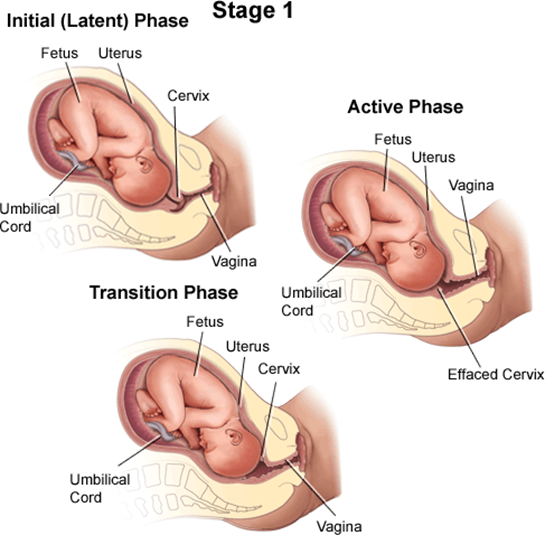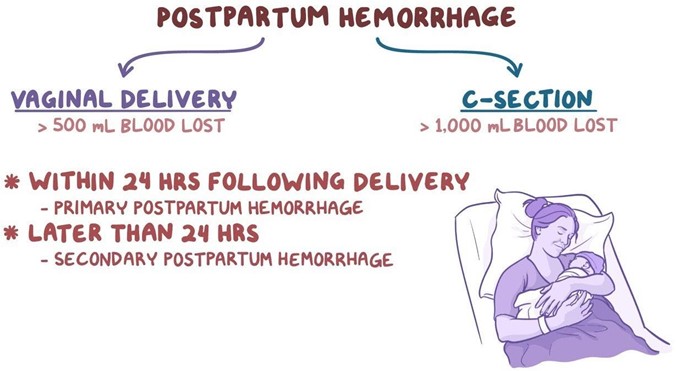A nurse is caring for a client who is in labor. Which of the following findings should prompt the nurse to reassess the client?
An urge to have a bowel movement during contractions
A sense of excitement and warm, flushed skin
Progressive sacral discomfort during contractions
Intense contractions lasting 45 to 60 seconds
The Correct Answer is A
A client who is in labor and reports an urge to have a bowel movement during contractions may be experiencing the transition phase of labor, which is the last and most intense part of the first stage of labor¹². The transition phase occurs when the cervix dilates from 8 to 10 cm and the baby descends into the birth canal¹². The pressure of the baby's head on the rectum can cause a sensation of needing to defecate¹². The transition phase can last from 15 minutes to an hour or more, and it can be accompanied by other signs, such as strong, regular, and painful contractions lasting 60 to 90 seconds; increased bloody show; nausea and vomiting; shaking and shivering; and emotional changes such as irritability, anxiety, or excitement¹²³.
The nurse should reassess the client who reports an urge to have a bowel movement during contractions because this may indicate that the client is close to delivering the baby and needs to be prepared for the second stage of labor, which involves pushing and giving birth¹². The nurse should check the client's cervical dilation, fetal heart rate, and maternal vital signs, and notify the provider if the client is fully dilated or shows signs of fetal or maternal distress¹². The nurse should also support the client's coping strategies, such as breathing techniques, relaxation methods, or pain relief options, and encourage the client not to push until instructed by the provider¹².
b) A sense of excitement and warm, flushed skin are not signs that require reassessment by the nurse. These are normal emotional and physiological responses to labor that reflect increased adrenaline levels and blood flow¹⁴. They do not indicate any complications or imminent delivery.
c) Progressive sacral discomfort during contractions is not a sign that requires reassessment by the nurse. This is a common symptom of labor that results from the pressure of the baby's head on the sacrum and nerves in the lower back¹⁴. It does not indicate any problems or imminent delivery.
d) Intense contractions lasting 45 to 60 seconds are not signs that require reassessment by the nurse. These are typical characteristics of active labor contractions, which occur when the cervix dilates from 4 to 8 cm¹⁴. They do not indicate any complications or imminent delivery.

Nursing Test Bank
Naxlex Comprehensive Predictor Exams
Related Questions
Correct Answer is ["A","D","E"]
Explanation
These are the findings that place the client at risk for postpartum hemorrhage. Postpartum hemorrhage (PPH) is severe vaginal bleeding after childbirth. It can be a life-threatening condition that requires prompt treatment. The most common cause of PPH is uterine atony, which is when the uterus does not contract enough to stop the bleeding from the placental site¹. Factors that can increase the risk of uterine atony include:
- History of uterine atony: Having a previous episode of PPH due to uterine atony makes it more likely to
happen again in subsequent deliveries.
- Labor induction with oxytocin: Oxytocin is a hormone that stimulates uterine contractions. However, prolonged or excessive use of oxytocin during labor can cause uterine fatigue and reduce its ability to contract after delivery.
- Vacuum-assisted delivery: A vacuum extractor is a device that helps deliver the baby by applying suction to the baby's head. This can cause trauma to the uterus and increase the risk of bleeding.
The other options are not correct because they are not risk factors for postpartum hemorrhage. Let me
explain why:
b) History of human papillomavirus
Human papillomavirus (HPV) is a common sexually transmited infection that can cause genital warts and cervical cancer. However, it does not increase the risk of postpartum hemorrhage. HPV may affect the cervix, but not the uterus or the placenta, which are the main sources of bleeding after delivery³.
c) Newborn weight 2.948 kg (6 Ib 8 oz)
This is a normal newborn weight and does not increase the risk of postpartum hemorrhage. A large baby (more than 4 kg or 8.8 Ib) may increase the risk of uterine atony by overdistending the uterus, but this is not the case for this newborn².

Correct Answer is C
Explanation
A nonstress test (NST) is a test in pregnancy that measures fetal heart rate in response to movement and contractions²³. A normal nonstress test will show a baseline fetal heart rate between 110 and 160 beats per minute with moderate variability (5- to 25-interbeat variability) and 2 qualifying accelerations in 20 minutes with no decelerations³⁴. An acceleration is defined as an increase in the fetal heart rate of at least 15 beats per minute above the baseline for at least 15 seconds²³⁴.
A nonstress test can be affected by uterine contractions, which can cause fetal heart rate decelerations or reduced variability²³. Uterine contractions can also indicate preterm labor or placental abruption, which are serious complications that require intervention². Therefore, if the nurse observes three or more uterine contractions within a 20-minute period during a nonstress test, they should intervene by notifying the provider, assessing the patient for signs of labor or bleeding, and preparing for further evaluation or treatment²⁵.
The other options are not correct because they do not require intervention by the nurse:
a) One acceleration of the FHR within a 20-min period is not enough to meet the criteria for a reactive nonstress test, but it does not indicate fetal distress or compromise. The nurse should continue monitoring the fetal heart rate for another 20 minutes or until two accelerations are observed²³⁴.
b) Uterine contractions lasting 20 to 30 seconds each are normal and expected during pregnancy, especially in the third trimester. They are called Braxton Hicks contractions and they help prepare the uterus for labor. They are usually painless and irregular, and do not cause cervical changes. They do not require intervention by the nurse unless they become frequent, intense, or painful².
d) An FHR that peaks 20 beats above the baseline is considered an acceleration and is a sign of fetal well- being. It does not require intervention by the nurse unless it is associated with decelerations or reduced variability²³⁴.
Whether you are a student looking to ace your exams or a practicing nurse seeking to enhance your expertise , our nursing education contents will empower you with the confidence and competence to make a difference in the lives of patients and become a respected leader in the healthcare field.
Visit Naxlex, invest in your future and unlock endless possibilities with our unparalleled nursing education contents today
Report Wrong Answer on the Current Question
Do you disagree with the answer? If yes, what is your expected answer? Explain.
Kindly be descriptive with the issue you are facing.
